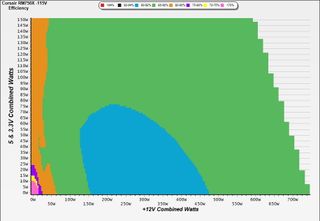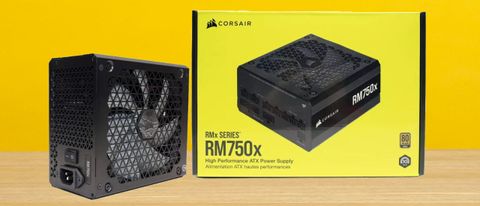Why you can trust Tom's Hardware
Protection Features
Check out our PSUs 101 article to learn more about PSU protection features.
| Protection Features | Row 0 - Cell 1 |
OCP (Cold @ 25°C) | 12V: 79.6A (127.36%), 11.918V 5V: 31.5A (157.5%), 5.009V 3.3V: 31.2A (156%), 3.295V 5VSB: 5.2A (173.33%), 4.946V |
OCP (Hot @ 42°C) | 12V: 79.8A (127.68%), 11.923V |
OPP (Cold @ 26°C) | 961.97W (128.26%) |
OPP (Hot @ 42°C) | 964.87W (128.65%) |
OTP | ✓ (139°C @ 12V Heat Sink) |
SCP |
12V to Earth: ✓ |
PWR_OK | Proper operation |
NLO | ✓ |
SIP | Surge: MOV |
OCP at 12V and OPP are correctly set, but this is not the case for OCP on the minor rails, which is set too high. No modern system requires such strong minor rails. Even if this is the case, so many Amperes at 5V and 3.3V will highly stress the corresponding DC-DC converters, especially under increased operating temperatures. All other protection features are present and operate fine.
DC Power Sequencing
According to Intel’s most recent Power Supply Design Guide (revision 1.4), the +12V and 5V outputs must be equal to or greater than the 3.3V rail at all times. Unfortunately, Intel doesn't mention why it is so important to always keep the 3.3V rail's voltage lower than the levels of the other two outputs.

DC Power Sequencing Scope Shots


No problems here since the 3.3V rail is always lower than the other two.
Cross Load Tests
To generate the following charts, we set our loaders to auto mode through custom-made software before trying more than 25,000 possible load combinations with the +12V, 5V, and 3.3V rails. The deviations in each of the charts below are calculated by taking the nominal values of the rails (12V, 5V, and 3.3V) as point zero. The ambient temperature during testing was between 30 to 32 degrees Celsius (86 to 89.6 degrees Fahrenheit).
Load Regulation Charts

Load Regulation Graphs


Efficiency Graph

Ripple Graphs
The lower the power supply's ripple, the more stable the system will be and less stress will also be applied to its components.

Ripple Suppression Graphs



Infrared Images
We apply a half-load for 10 minutes with the PSU's top cover and cooling fan removed before taking photos with a modified FLIR E4 camera able to deliver an IR resolution of 320x240 (76,800 pixels).

IR Images




The hottest part is the board hosting the 12V FETs, which gets close to 80 degrees Celsius. Still, this is not a high temperature given the operating conditions and the FETs' high-temperature limits.
MORE: Best Power Supplies
MORE: How We Test Power Supplies
MORE: All Power Supply Content
Current page: Protection Features, DC Power Sequencing, Cross-Load Tests and Infrared Images
Prev Page Load Regulation, Hold-Up Time, Inrush & Leakage Current, Efficiency and Noise Next Page Transient Response Tests, Timing Tests, Ripple Measurements and EMC Pre-Compliance TestingAris Mpitziopoulos is a Contributing Editor at Tom's Hardware US, covering PSUs.
-
RAZ0RLIGHT Is there any reason why the 2021 revisions fan curve is so much more aggressive?Reply
This would be the perfect Gold PSU if they would have implemented the same fan curve as the older 2018 revision. -
I Reply
Disagree. It's still very quiet and I'd rather a tiny noise increase to reduce temps, increase lifespan.RAZ0RLIGHT said:Is there any reason why the 2021 revisions fan curve is so much more aggressive?
This would be the perfect Gold PSU if they would have implemented the same fan curve as the older 2018 revision.
This is probably what Corsair determined as well through wear testing, decided that not only would that reduce their warranty fulfillment costs but also improve customer satisfaction by having a longer lasting product.
If you don't care about the warranty, crack it open, put a few tens of ohms 2W resistor in series on the fan power lead, or just swap in a lower RPM fan, or mod the fan control circuit, or wear earplugs, or put the system under your desk, or get a cat plus 100 mice let loose all at once and you'll never even notice the very slight fan noise.
Besides, it's all a bit silly. If your system is pulling that many amps it's going to need its own more audible fans running anyway. For good lifespan. An internal, reward-facing exhaust, oriented fan is the least audible way to pull or push air through a system. -
Russll HelloReply
A few days ago I bought a Corsair RM750x (2021). Now the power supply consumes little (20-30%) because it works without a video card (AMD 5700G only).
The Aida64 and OCCT show voltage on rail +12V - 11.884V, and on rail +3.3VCC - 3.248V, on rail +5V - 4.980V (computer idle, browser only).
In the game, the voltage rises and shows on rail + 12V - 11.980V (maximum), and on rail + 3.3VCC - 3.264V (maximum), on rail + 5V - 5.020V.
Is this normal at all.?
There is no full 12V on rail + 12V, and no full 3.3V on rail + 3.3V..
Maybe I should return the product to the store.?
-
drivinfast247 Reply
Perfectly normal operation.Russll said:Hello
A few days ago I bought a Corsair RM750x (2021). Now the power supply consumes little (20-30%) because it works without a video card (AMD 5700G only).
The Aida64 and OCCT show voltage on rail +12V - 11.884V, and on rail +3.3VCC - 3.248V, on rail +5V - 4.980V (computer idle, browser only).
In the game, the voltage rises and shows on rail + 12V - 11.980V (maximum), and on rail + 3.3VCC - 3.264V (maximum), on rail + 5V - 5.020V.
Is this normal at all.?
There is no full 12V on rail + 12V, and no full 3.3V on rail + 3.3V..
Maybe I should return the product to the store.?
-
stateofdade Just purchased one of these based on this review. Thanks for the information and the deep dive into this PSU.Reply -
NoxMorbis I can't believe they used in cable caps. Shoddy and ridiculous. I have the 2018 RMX and I HATE those inline crap caps. I also looked at the soldering and found flux still stuck to the joints. Shoddy soldering is apparent. Geeze, what a quality control step down. I just think in line caps are fudging, although In know most do it.Reply
